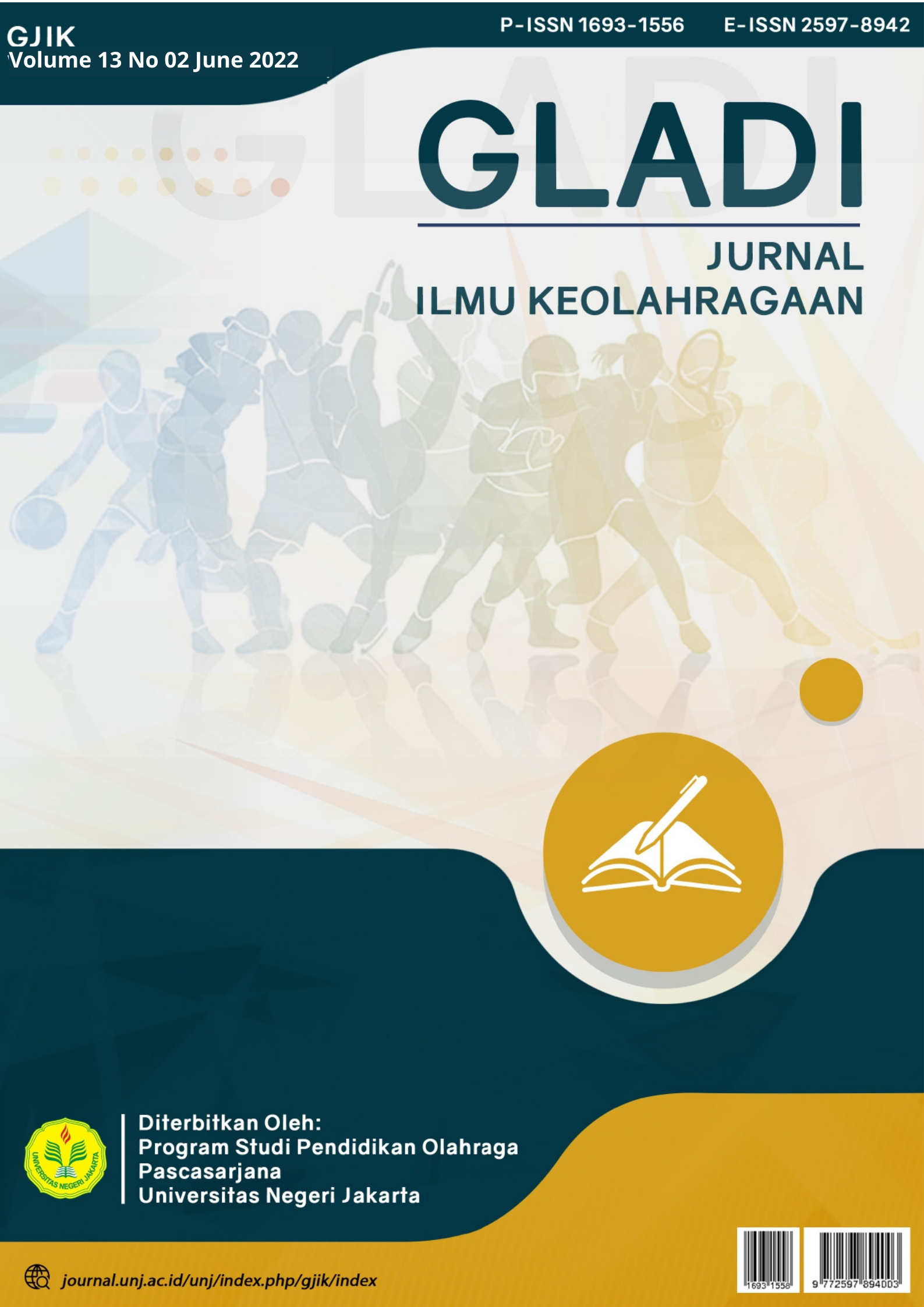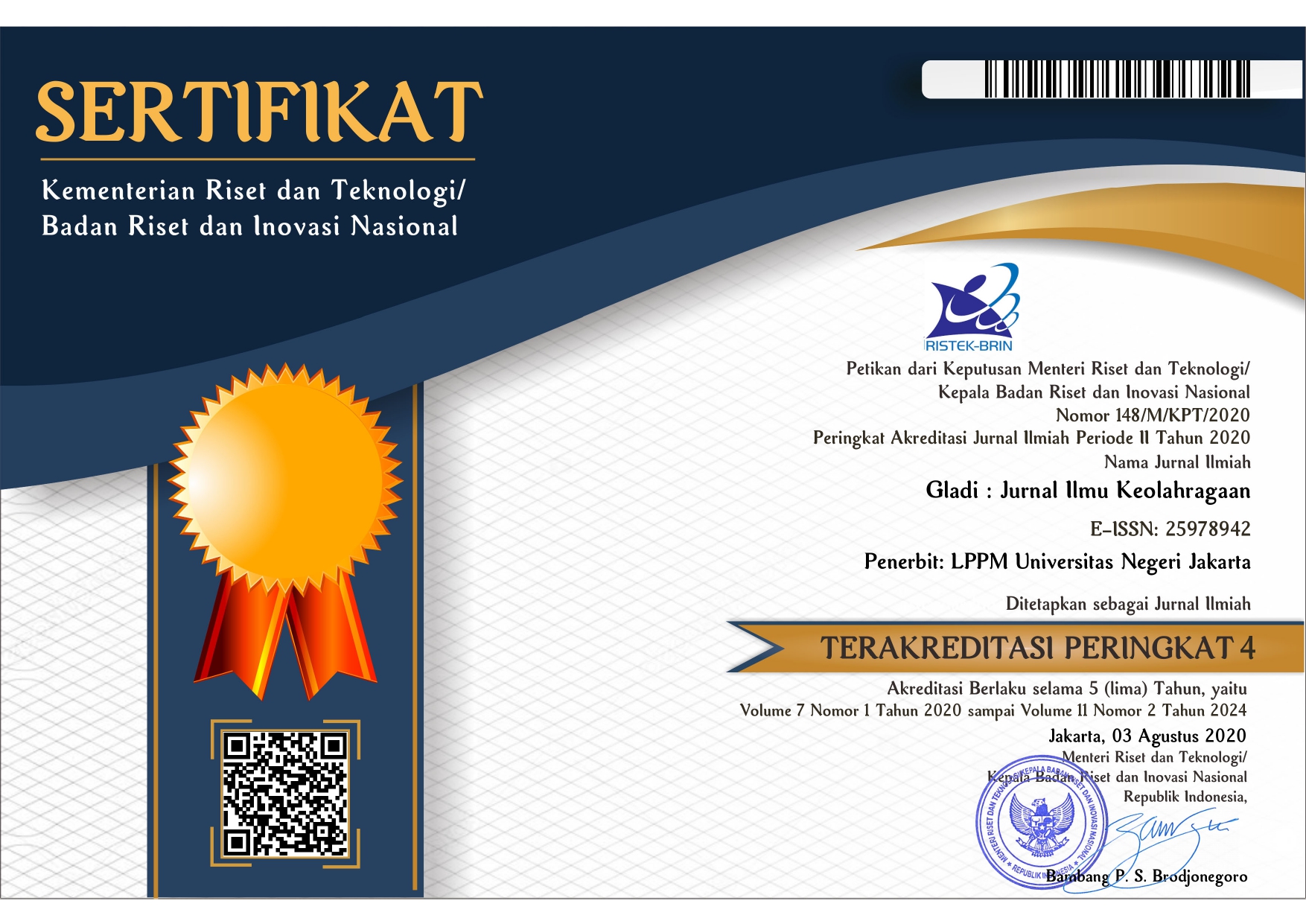Program evaluation of southeast sulawesi student sports center for development and training
Keywords:
Evaluation, CIPP, Training, Sport centerAbstract
The purpose of this study was to determine the results of the evaluation of the Southeast Sulawesi Student Sports Training and Development Center which included the components of context, input, process and product. This research is a type of evaluation research through a quantitative and qualitative approach. Program evaluation is carried out to determine the achievement of the targets that have been set. Then make a decision on the program. In the program evaluation research using the CIPP evaluation model, namely context, input, process, product. The four evaluation aspects are used to determine the implementation of the Southeast Sulawesi Student Sports Training and Development Center Program. The research subjects selected were stakeholders as many as 30 respondents, namely athletes, coaches, and the Head of the Southeast Sulawesi Youth and Sports Office. Apart from informants from the stakeholders, the subjects of this research are documents related to the Southeast Sulawesi Student Sports Training and Development Center Program.
Downloads
References
Coaching Program Of Measurable Sports ( Athletics , Weightlifting , Archery , And Swimming ) In Lampung Province. 8(1), 56–61.
Aji, T. (2013). Pola Pembinaan Prestasi Pusat Pendidikan dan Latihan Pelajar
( PPLP ) Sepak Takraw Putra Jawa Tengah Tahun 2013. 3.
Amir, F. (2015). Developing Structure For Management Of Quality In Schools : Steps Towards Quality Assurance Systems. 3(8), 977–981. Https://Doi.Org/10.12691/Education-3-8-5
Arikunto, S. (2013) dasar-dasar evaluasi pendidikan. Jakarta. Bumi Aksara
Arikunto, Suharsimi dan Abdul Jabar, Cepi Safrudin. (2014). Evaluasi Program Pendidikan, Pedoman Teoritis bagi Praktisi Pendidikan. Jakarta: Bumi Aksara.
Azizi Yahaya (2001). "The Using of Model Context, Input, Process and Product (CIPP) in Learning Program Asessment," International Conference on
Challanges and Prospect in Teacher Education, Universitas Teknologi Malaysia, Juli, hh. 3.
Cummings, Rick. (2006). “What if: The Counterfactual in Evaluation Program”. Evaluation Journal Australasia. Vol. 6, Spring, h. 6-15
David Royse, et. al., (2006) Program Evaluation an Introduction (Toronto: Thomson Brooks,), hh.11.
Daniel L. Stuflebeam. (2001). The In CIPP Model For Evaluation (Boston: Kluwer Academic Publishers).
Depdiknas, (2003) Teknik Pemanduan Bakat Olahraga, (Jakarta; Dirjen Olahraga Depdiknas), hh.10.
Depdiknas (2002), Pedoman dan Modul Pelatihan Kesehatan Olahraga bagi Pelatih Olahragawan Pelajar, (Jakarta: Depdiknas, PPKJ,), hh. 103.
Hatfield, J. (2003). Evaluability Assessment A Catalyst For Program Change And Improvement A Catalyst For Program Change. January 2014. Https://Doi.Org/10.1177/016327870325226
Harshit Topno. (2012). “Evaluation of traininig and development: An Analysis of Various Models”, Journal of Business and Manajement Vol 5 (2).
James A. Williams a ,, Eric A. Brown b, Mirannda Kitterlin c, S.B (2017) Intaramular Sport Particiapation produce self-efficacy in hospitaly leaders. Journal of hospitaly and Tourism Management. 3(5), 41-52
James Tangkudung. (2006) Kepelatihan Olahraga Pembinaan Prestasi Olahraga. (Jakarta: Cerdas Jaya), hh. 27
Joan, S. James. (2013). “An Evaluation of the Implementation of Aspects of The Revised Jamaican Primary Science Curriculum and Enactment of Profesional Develompment,” Journal of The University of The West Indies, Vol 2 (3).
John A. Mclaughlin, G. B. J. (N.D.). Logic Models ] A Tool For Telling Your Program | S Performance Story. 54–61.
John M. Owen. (2006) Program Evaluation Form and Approach (Crown Nest, NSW: Midlands Typesetters), hh. 48.
Jopang, J. (2018). Kebijakan Pembinaan Atlet Pusat Pendidikan Dan Latihan Pelajar Dinas Kepemudaan Dan Olah Raga Propinsi Sulawesi Tenggara. Journal Publicuho, 1(1), 1. https://doi.org/10.35817/jpu.v1i1.5846
Juana Budi Aryanto Muslim2. (2017). Bevaluasi Penyelenggaraan Program Pusat Pendidikan Dan ( Pusat Pendidikan dan Latihan Pelajar ). 08(02), 92–102.
Judith Bennet. (2003). Evaluation Methods in Reseach (New York:
Continuum), hh. 30
Jody L. Fitzpatrick (2004). Program Evaluation Alternative Approaches and Practical Guidelines (Boston: Pearson), hh. 141
Joy A. Frechtling (2007). Logic Modeling Methode in Program Evaluation (Arlington: John Wiley & Son Inc), hh. 20-43
James C. Mc David, dan Laura R. L. Hawthorn. (2006). Program Evaluation and Performance Measurement: An Introduction to Practice (California: Sage Publication), hh. 114
Kemenpora. (2005). Undang-Undang Nomor 3 Tahun 2005 Sistem Keolahragaan Nasional. (Jakarta: Kemenpora), hh. 18
Laura. L, Claire L.(2006). Public Program Evaluation: a Statistical guide. Armonk New York.. Hl.3
Margantara, A. F. (2020). Evaluasi Program Kegiatan Keolahragaan Di Koni Kabupaten Kudus.
Miles Mc Nall, Pennie G Foster Fishman. (2007). “Methods of Ripid Evaluation Assessment, and Appraisal,” American Journal of Evaluation. Vol. 28 (2).
Michael Demarteu. (2002). "A Theoritical Frame and Grid for Analysis of Programe Evaluation Practices," Journal of Evaluation, Vol. 8 (4), hh. 457.
Nations, U., & Programme, E. (2007). Lessons Learned From Evaluation A Platform For Sharing Knowledge. 2.
Porteous, N. L., & Stewart, P. J. (2002). Introducing Program Teams To Logic Models : Facilitating The Learning Process. 17(3).
R. Lance Hogan. (2007). “The Historical Development of Program Evaluation: Exploring The Past and Present.” Online Journal of Workforce Educational and Development. Vol. 2(4), Spring.
Sandra Mathison, Encyclopedia of Evaluation (California: Sage Publication, 2005), hh. 90.
Saputra, A., Keolahragaan, F. I., Padang, U. N., Jakarta, U. N., & Artikel, I. (2020). Jurnal Performa Olahraga. 5, 1–5.
Sandra Mathison. (2005). Encyclopedia of Evaluation (California: Sage
Publication), hh. 118
Sugiyono. (2005). Memahami Penelitian Kualitatif (Bandung: CV. Alfabeta), hh.199
Sukardi. (2014). Evaluasi Program Pendidikan dan Kepelatihan (Jakarta: PT Bumi Aksara), h.62.
Sugyanto. (2012). Dimensi Kajian Ilmu Keolahragaan. Jurnal Sport Science, Vol.01. Universitas Negeri Yogyakarta.
Sopha, S., & Nanni, A. (2019). The Journal Of Asia TEFL The CIPP Model : Applications In Language Program Evaluation. 16(4), 1360–1367.
Stufflebeam, D. L. (2003). The Cipp Model For Evaluation ! ! !
Suharsimi Arikunto dan Cepi, S.A.J. (2009). Evaluasi Program Pendidikan.
(Jakarta : Bumi Aksara), hh.1.
Saryono dan Mekar, D.A. (2010). Metodelogi Penelitian Kualitatif dalam Bidang Kesehatan (yogyakarta: Muha Medika), hh.78
Suharsimi Arikunto. (2009). Evaluasi Program Pendidikan (Jakarta: Bumi Aksara), hh.200.
Tudor O. Bompa. (2005). Theory and Metodology of Training, (Dubuque: Kendall/Hunt Publishing Company), hh. 2
Topno, H. (2012). Evaluation Of Training And Development : An Analysis Of Various Models. 5(2), 16–22.
Wangsa, J. (2017). Evaluasi Penyelenggaraan Program PPLP ( Pusat Pendidikan
Dan Latihan Pelajar ).
Wani, B. (2018). Evaluasi Program Pembinaan Prestasi Cabang Olahraga
Tinju Pada Pusat Pembinaan Dan Latihan Olahraga Pelajar
( PPLP ). 5(1), 35–43.
W. Gulo. (2005). Metode Penelitian (Jakarta: PT. Gramedia Widiasrana Indonesia), hh.123
Wiliam Dunn. (2001). Public Policy, terjemahan Muhadjir Darwin.
(Yogyakarta: PT. Hanindita Graha Widia), hh. 608
Yolif Citra Resmi, 2014. (n.d.). Yolif Citra.
Yusrizal, Nuzuli, I. (2015). Keberadaan PPLP Olahraga Dayung Provinsi Aceh Tahun 2012. 1, 168–176







